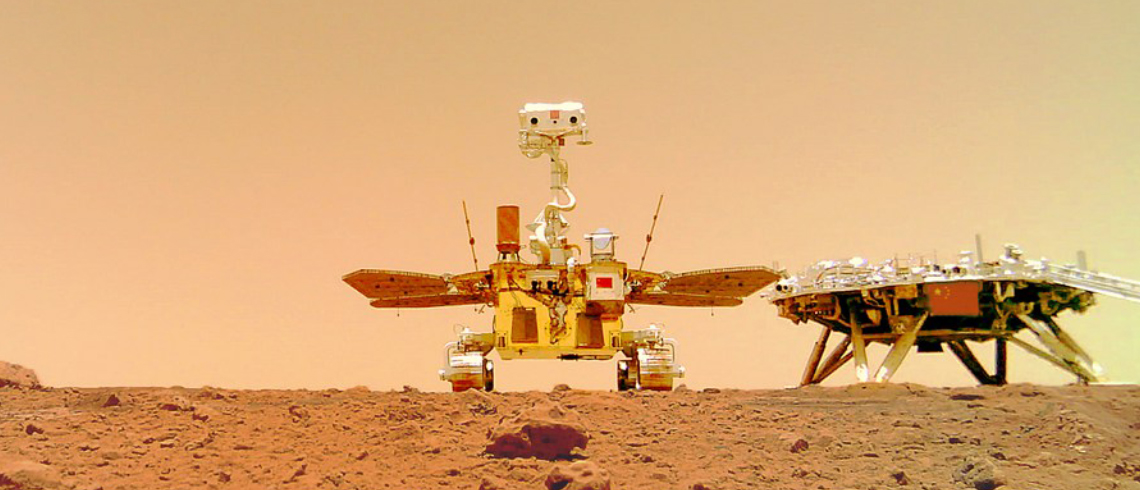China’s TOP10 breakthroughs in science and technology in 2022

China’s Ministry of Science and Technology has released its top 10 breakthroughs in science and technology for 2022. These breakthroughs span various areas, including aerospace exploration, COVID-19 genetic research, chemical synthesis techniques, clean energy, quantum computing, high-performance memory storage, and material science.
Here are the top 10 breakthroughs in science and technology of 2022 in China:
1. Zhurong Probe Radar Uncovers Subsurface Structure of Mars’ Utopia Planitia
 The Zhurong Mars Rover conducted in-situ radar exploration in the Utopia Planitia, revealing for the first time the finely layered structure of the shallow subsurface of the Utopia Planitia. (Image design: research team of the Institute of Geology and Geophysics, Chinese Academy of Sciences; Image drawing: Deng Jun, Wuhan University)
The Zhurong Mars Rover conducted in-situ radar exploration in the Utopia Planitia, revealing for the first time the finely layered structure of the shallow subsurface of the Utopia Planitia. (Image design: research team of the Institute of Geology and Geophysics, Chinese Academy of Sciences; Image drawing: Deng Jun, Wuhan University)
China’s Tianwen-1 probe radar has revealed the shallow stratification of the Utopia Planitia on Mars, providing crucial evidence for understanding the geological evolution and environmental and climate changes on Mars.
2. FAST Observatory Captures Active and Recurring Fast Radio Bursts

FAST (Five-hundred-meter Aperture Spherical Radio Telescope) has precisely characterized active repeating fast radio bursts, laying the observational foundation for ultimately revealing their origins. Fast radio bursts (FRBs) are the most intense explosions in the cosmic radio wave spectrum, with unknown origins, and are one of the major hot topics in astronomy.
3. New Technology Enables Hydrogen Production from Seawater via Direct Electrolysis
 The principle and technical prototype
The principle and technical prototype
Research on a new principle for direct seawater electrolysis for hydrogen production has laid the foundation for solving long-standing technical problems in this field for both the scientific community and industry. The side reactions and corrosion caused by the complex components of seawater have always been major challenges for directly producing hydrogen through seawater electrolysis.
4. Mutation Characteristics and Immune Escape Mechanisms of SARS-CoV-2 Discovered
 Prediction of the mutation sites in the receptor binding domain of the novel coronavirus that mediate immune escape.
Prediction of the mutation sites in the receptor binding domain of the novel coronavirus that mediate immune escape.
The study has revealed the mutation characteristics and immune escape mechanisms of the new coronavirus, providing scientific guidance for vaccine development and precise treatment.
5. Design and fabrication of bifacial all-perovskite tandem solar cells.

The achievement of efficient all-perovskite stacked solar cells and modules provides new directions for the development of high-efficiency and low-cost solar cells.
6. Elemental electrical switch enabling phase segregation–free operation offers High-Performance Storage Solutions
 Schematic diagram of a new principle switch device.
Schematic diagram of a new principle switch device.
New principle-based switching devices provide new technical solutions for the development of massive storage and near-memory computing. High-density and massive storage is crucial for the development of information technology and the digital economy in the era of big data.
7. Creation of an ultracold gas of triatomic molecules from an atom–diatomic molecule mixture

The quantum coherent synthesis of ultracold triatomic molecules has been achieved, opening up new directions for research in ultracold chemistry and quantum simulation.
8. Ambient-pressure synthesis of ethylene glycol catalyzed by C60-buffered Cu/SiO2
Research on its synthesis under mild pressure conditions could potentially reduce dependence on petroleum-based technology routes. Ethylene glycol mainly comes from petrochemicals.
9. Three-dimensional direct lithography of stable perovskite nanocrystals in glass with femtosecond laser
 Schematic diagram of femtosecond laser-induced bandgap-controlled structures and implementation of 3D patterning.
Schematic diagram of femtosecond laser-induced bandgap-controlled structures and implementation of 3D patterning.
Femtosecond laser-induced micro-nanostructure formation in complex systems has discovered new mechanisms, laying the foundation for the application of perovskite nanocrystals in photonics and optical devices.
10. Discovery of segmented Fermi surface induced by Cooper pair momentum
Experimental research on the “segmented Fermi surface” in the superconducting state has paved the way for new methods of controlling physical states and constructing novel topological superconductors. Artificial control of the Fermi surface is the most important approach to material property regulation.
These breakthroughs are pushing the boundaries of human knowledge and will undoubtedly have a significant impact on science and technology. Overall, the future looks bright with these significant breakthroughs, and we can eagerly anticipate what further advances may come in 2023 and beyond.
Wang, H., Yang, M. A., Wangdue, S., Lu, H., Chen, H., Li, L., Dong, G., Tsrin, T., Yuan, H., Fu, Q., & 27 others. (2023). Human genetic history on the Tibetan Plateau in the past 5100 years. Science Advances, 9(11), eadd5582. https://doi.org/10.1126/sciadv.add5582
Yang, J., Jin, Z. B., Chen, J., Qu, J. (2017). Genetic signatures of high-altitude adaptation in Tibetans. Proceedings of the National Academy of Sciences, 114(16), 4189-4194. https://doi.org/10.1073/pnas.1617042114



